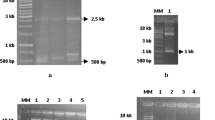Summary
The nucleotide sequence and derived amino acid sequence of a cDNA clone (BLT4) for a low temperature induced barley gene were determined. This gene, together with a small family of related genes, was shown to reside on chromosome 3. The BLT4 clone has homology with genes in wheat and oats. Its expression was studied in oats and in barley doubled haploid lines segregating for spring/winter habit and for frost hardiness. These analyses show that elevated steady state levels of BLT4 mRNA are produced in shoot meristematic tissue after 3 days low positive temperature treatment. The low temperature response was found in all barley doubled haploid lines and was therefore not associated specifically with either the spring/winter habit or frost hardiness. Elevated levels of BLT4 mRNA were also seen in drought-stressed barley and it is likely that this is a gene encoding a low molecular weight protein that is responsive to dehydrative stresses, such as cold and drought.
Similar content being viewed by others
References
Brule-Babel AL, Fowler DB (1988) Genetic control of cold hardiness and vernalisation requirement in rye. Genome 32:9–23
Campos FAP, Richardson M (1984) The complete amino acid sequence of the β-amylase inhibitor 1–2 from seeds of ragi (Indian finger millet Eleusine coracana Gaerth). FEBS Lett 167:221–225
Cattivelli L, Bartels D (1990) Molecular cloning and characterisation of cold-regulated genes in barley. Plant Physiol 93:1504–1510
Dellaporta SL, Wood J, Hicks JB (1983) A plant DNA minipreparation: Version II Plant Mol Biol Rep 1:19–21
Doll H, Haahr V, Sogaard B (1989) Relationship between vernalisation requirement and winter hardiness in doubled haploids of barley. Euphytica 42:209–213
Dunn MA, Hughes MA, Pearce RS, Jack PL (1990) Molecular characterisation of a barley gene induced by cold treatment. J Exp Bot 41:1405–1413
Fletcher RJ, Cullis BR (1988) Evaluation of chromosome substitution lines of wheat (Triticum aestivum L) for freezing injury suffered during the stem elongation stage of development. Aust J Agric Sci 39:111–128
Fowler DB, Carles RJ (1979) Growth, development and cold tolerance of fall-acclimated cereal grains. Crop Sci 19:915–922
Hajela RK, Horvath DP, Gilmour SJ, Thomashow MF (1990) Molecular cloning and expression of cor (Cold-Regulated) genes in Arabidopsis thaliana. Plant Physiol 93:1246–1252
Hughes MA, Dunn MA (1990) The effect of temperature on plant growth and development. Biotechnol Genet Eng Rev 8:161–188
Hughes MA, Pearce RS (1988) Low temperature treatment of barley plants causes altered gene expression in shoot meristems. J Exp Bot 39:1461–1467
Islam AKMR, Shepherd KW, Sparrow BDH (1981) Isolation and characterisation of euplasmic wheat-barley chromosome addition lines. Heredity 46:161–174
Koes RE, Spett CE, Mol JNM, Gerais AGM (1987) The chalcone synthase multigene family of Petunia hybrida (V30): sequence homology, chromosomal location and evolutionary aspects. Plant Mol Biol 10:159–169
Kurkela S, Franck M (1990) Cloning and characterisation of a cold- and ABA-inducible Arabidopsis gene. Plant Mot Biol 15:137–144
Kyte J, Doolittle RF (1982) A simple method for displaying the hydropathic character of a protein. J Mol Biol 157:105–132
Marsh JL, Erfle M, Wykes EJ (1984) The plC plasmid and phage vectors with versatile cloning sites for recombinant selection by insertional inactivation. Gene 32:481–485
Mohapatra SS, Wolfram L, Poole RJ, Dhindsa RS (1989) Molecular cloning and relationship to freezing tolerance of cold-acclimation-specific genes of alfalfa. Plant Physiol 89:375–380
Mundy J, Rogers JC (1986) Selective expression of a probable amylase/protease inhibitor in barley aleurone cells: comparison to barley amylase/subtilisin inhibitor. Planta 169:51–63
Olien CR (1964) Freezing processes in ‘Hudson’ barley (Hordeum vulgare L). Crop Sci 4:91–95
Peacock JM (1975) Temperature and leaf growth of Lolium perenne II The site of temperature perception. Ann Appl Ecol 12:115–123
Pearce RS (1988) Extracellular ice and cell shape in frost stressed cereal leaves: a low-temperature scanning-electron-microscopy study. Planta 175:313–324
Sambrook J, Fritsch EF, Maniatis T (1989) Molecular cloning: A laboratory manual. Cold Spring Harbor Laboratory Press, Cold Spring Harbor, NY
Schaffer MA, Fischer RL (1988) Analysis of mRNAs that accumulate in response to low temperature identifies a thiol protease gene in tomato. Plant Physiol 87:431–436
Steponkus PL (1978) Cold hardiness and freezing injury of agronomic crops. Adv Agron 30:51–98
Sutka J, Snape JW (1989) Location of a gene for frost resistance on chromosome 5A of wheat. Euphytica 42:41–44
Svensson B, Asano K, Jonassen IB, Poulsen FM, Mundy J, Svendsen IB (1986) A 10Kd barley seed protein homologous with an β-amylase inhibitor from Indian finger millet. Carlsberg Res Commun 51:493–500
Takahashi R, Yasuda S (1970) Genetics of earliness and growth habit in barley. In: Nilan RA (ed) Barley genetics II. Proc 2nd Int Barley Genet Symp. Washington State University Press, pp 388–408
Thomas H, Stoddart JL (1984) Kinetics of leaf growth in Lolium temulentum at optimal and chilling temperatures. Ann Bot 53:341–347
Watts WR (1972) Leaf extension of Zea mays II Leaf extension in response to independent variation of the temperature of the apical meristem, of the air around the leaves and the root zone. J Exp Bot 23:713–721
Yanisch-Perron C, Vieira J, Messing J (1985) New M13 host strains and complete sequences of M13mp and pUC vectors. Gene 33:103–119
Author information
Authors and Affiliations
Additional information
Communicated by E. Meyerowitz
The EMBL accession number for BLT4 is X56547 H. vulgare cDNA
Rights and permissions
About this article
Cite this article
Dunn, M.A., Hughes, M.A., Zhang, L. et al. Nucleotide sequence and molecular analysis of the low temperature induced cereal gene, BLT4. Molec. Gen. Genet. 229, 389–394 (1991). https://doi.org/10.1007/BF00267460
Received:
Issue Date:
DOI: https://doi.org/10.1007/BF00267460




